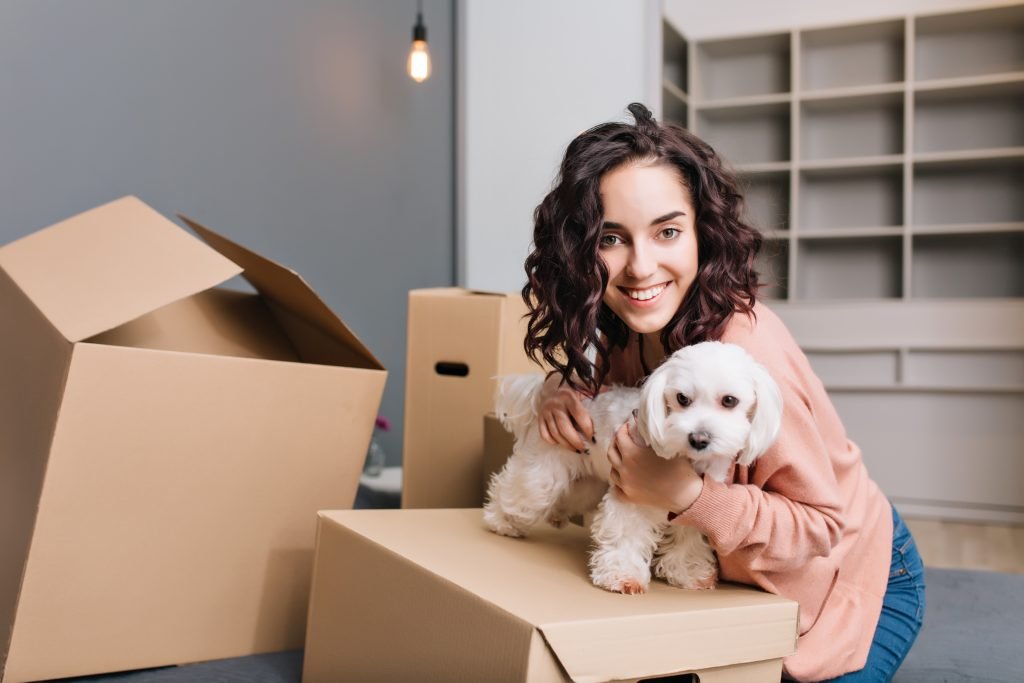Moving long-distance can be a challenging experience, especially when you have pets to consider. From managing their comfort and safety to ensuring their smooth transition into a new environment, there’s a lot to think about. This guide will help you navigate the process, offering tips to keep your pets calm, secure, and well-cared-for throughout your journey. Now with the guidance of Fat Cat Movers, let’s dive into how you can make this move as stress-free as possible for your beloved companions.

Whether you’re relocating across state lines or just a few hundred miles away from Houston, planning ahead for your furry friends can make a huge difference. It’s essential to create a pet-friendly moving plan that includes everything from packing their essentials to finding pet-friendly accommodations. Engaging long-distance movers who understand the needs of pets can also ensure a smoother transition for your animals, as they may offer additional support and advice for moving with pets.
Preparing Your Pet for a Long-Distance Move
Before embarking on a long-distance move, it’s crucial to prepare your pet for the transition. Begin by visiting your veterinarian for a check-up to ensure your pet is healthy and up-to-date on vaccinations. Discuss any specific needs or concerns related to travel. If your pet is not already microchipped, consider having this done, as it can help in case they get lost. Gradually acclimate your pet to their travel carrier by placing their favorite toys and bedding inside to create a sense of familiarity. Additionally, practice short trips in the carrier to help reduce anxiety and avoid common mistakes like failing to prepare your pet for the journey or not considering their comfort and safety.
Choosing Pet-Friendly Moving Services
Selecting the right moving service can make a significant difference in how well your pet adjusts to the move. Look for moving companies that offer pet-friendly services, such as those that can accommodate your pet’s travel needs and provide advice on moving with animals. Consider factors like climate-controlled transport or specialized handling services for pets, which can ensure their safety and comfort. Research companies thoroughly, asking about their experience with pet relocations and their approach to pet care during the move. Read reviews and seek recommendations from other pet owners to ensure you choose a reliable and understanding moving service. Ensuring these factors can help make the transition smoother for both you and your furry friend.
Packing Your Pet’s Essentials
When preparing for your move, packing your pet’s essentials is key to ensuring they have everything they need. Create a special moving kit that includes food, water, bowls, medications, and any other daily necessities. Don’t forget their favorite toys, bedding, and grooming supplies, which will provide comfort and familiarity in the new environment. Keep these items easily accessible, so you can quickly set up a familiar space for your pet in your new home. If you’re traveling by car, pack a travel bag with these essentials and any necessary documents, such as your pet’s medical records, to ensure you’re prepared for any situation.
Ensuring Your Pet’s Safety During Transit
Ensuring your pet’s safety during transit is essential for a smooth move. If traveling by car, secure your pet in a well-ventilated, comfortable crate or carrier. Make frequent stops to check on their well-being, provide water, and offer short walks if possible. For long-distance moves, consider using a pet transport service that offers climate-controlled environments and experienced handlers. If your pet is traveling by air, choose a reputable airline with experience in animal transport and follow their guidelines for crate preparation. Always carry your pet’s identification, including tags and microchip information, and have their health records readily available to address any issues that may arise.
Finding Pet-Friendly Accommodations
Securing pet-friendly accommodations is a crucial step in your moving process. Before the move, research and book lodging that welcomes pets, whether it’s temporary accommodations or your new home. Many rental properties and hotels have specific pet policies, so ensure you understand any additional fees or requirements. Look for accommodations with amenities like nearby parks or walking areas to help your pet adjust. When moving into a new home, check the property’s pet policies and ensure it has a secure yard or safe areas for your pet to explore. By planning ahead, you’ll make the transition smoother for both you and your furry friend.
Maintaining Your Pet’s Routine During the Move
Maintaining your pet’s routine during a move helps reduce stress and anxiety. Keep feeding and exercise schedules as consistent as possible, even amidst the chaos of packing and relocating. Stick to familiar routines by feeding your pet at the same times and maintaining regular walks or playtimes. If possible, involve your pet in packing by allowing them to see and smell their belongings as you prepare. This familiarity can provide comfort and help them feel more secure. Maintaining routine in their daily activities can offer stability and reassurance, making the transition to your new home more comfortable for your pet.

Preparing Your New Home for Your Pet
Before moving in, prepare your new home to ensure it’s safe and welcoming for your pet. Pet-proof the space by removing any hazards such as toxic plants, sharp objects, or small items that could be swallowed. Set up a designated area with your pet’s bed, food, and water bowls to create a familiar space. Ensure there are secure boundaries if you have a yard or outdoor space, and check for any escape routes or hazards. Introducing your pet gradually to different areas of the home can help them adjust more comfortably. By making your new home pet-friendly from the start, you can ease their transition and help them settle in more quickly.
Managing Pet Anxiety and Stress
Managing pet anxiety and stress is essential during a move to ensure your pet remains calm and comfortable. Begin by maintaining a calm demeanor yourself, as pets often pick up on their owner’s emotions. Use calming products such as pheromone diffusers, anxiety wraps, or soothing treats to help alleviate stress. Keep your pet’s routine as consistent as possible and provide plenty of attention and reassurance. If your pet shows signs of extreme anxiety, consult with your veterinarian for additional strategies or medications that may help. Creating a safe, quiet space in your new home where your pet can retreat and relax will also aid in their adjustment.
Updating Your Pet’s Identification and Records
Updating your pet’s identification and records is crucial before and after your move. Ensure your pet’s microchip information is current with your new address and contact details. Update their ID tags with your new address and phone number, and carry a copy of their medical records, including vaccination history and any ongoing treatments. If you’re moving to a new state, research local pet licensing requirements and ensure your pet is properly registered. These updates are essential for your pet’s safety and well-being, helping to ensure they are easily identifiable and can receive the necessary care in your new location.
Travel Tips for Different Types of Pets
Different types of pets have unique needs during travel, so tailor your approach accordingly. For dogs, ensure they have comfortable travel crates and are accustomed to car rides. For cats, use secure carriers and consider calming products to reduce stress. Small pets, like birds or rodents, may require specialized travel containers and temperature control. Ensure that any necessary medications or dietary needs are met during transit. Research specific travel tips for each type of pet to ensure their safety and comfort. Planning ahead with the right equipment and strategies will help make your pet’s travel experience as smooth as possible.
Settling Your Pet into Your New Home
Settling your pet into your new home requires patience and care. Begin by setting up a familiar space with their bed, toys, and food to create a sense of security. Gradually introduce them to different areas of the home, allowing them to explore at their own pace. Maintain a consistent routine to provide stability and comfort. Be attentive to any changes in behavior, as moving can be stressful for pets. Offer plenty of reassurance and spend quality time with your pet to help them adjust. By providing a supportive environment and addressing their needs, you can help your pet settle in and feel at home in their new surroundings.
Conclusion
Moving with pets can be a smooth process with proper planning and care. By preparing your pet for the journey, choosing suitable pet-friendly moving services, and ensuring their comfort during transit, you can significantly reduce their stress. Setting up their essentials, maintaining routines, and preparing your new home will help your pet adjust more quickly to their new environment. Remember to update their identification and records and manage any anxiety with appropriate measures. With thoughtful preparation and attention to your pet’s needs, you can make your long-distance move a positive experience for both you and your furry friend, ensuring a smooth transition to your new home in Houston.
FAQs
How can I prepare my pet for a long-distance move?
Start by gradually getting your pet used to their travel crate and practicing short trips. Ensure they have their essentials, such as food, water, and comfort items, during the move.
What should I include in my pet’s travel kit?
Your pet’s travel kit should include their food, water, bowls, medications, leash, and familiar toys or bedding. Don’t forget their identification and any necessary documents.
How can I find pet-friendly accommodations during the move?
Research and book pet-friendly hotels or rental properties in advance. Websites like BringFido or PetsWelcome can help find suitable options along your route.
What are the best ways to manage my pet’s anxiety during the move?
Maintain a consistent routine and provide comfort items that smell like home. Use calming products like pheromone diffusers or consult your vet for anxiety solutions.
How should I set up my new home for my pet?
Create a designated area with their bed, toys, and food bowls to help them adjust. Gradually introduce them to different areas of the home and maintain their routine as much as possible
